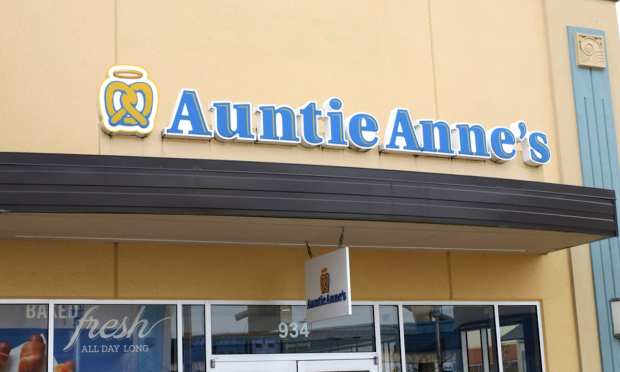Auntie Anne’s Pivots To Drive-Thrus Vs. Malls For Its Pretzels

As restaurants throughout the country rethink store design for the post-COVID future, pretzel chain Auntie Anne’s is getting out of the mall and into our cars. The chain’s parent company, Focus Brands, recently announced the first-ever Auntie Anne’s drive-thru location in partnership with fellow Focus Brands-owned chain Jamba (formerly known as Jamba Juice).
“The demand for consumer accessibility has played an influential role in our focus in expanding Auntie Anne’s outside of our traditional mall locations, and we know the emphasis on drive-thru access has staying power,” Alisa Gmelich, chief brand officer for Auntie Anne’s, told PYMNTS in an interview. “In fact, we hope to open four additional drive-thru locations across the country this year alone.”
The drive-thru has experienced something of a renaissance in the past 14 months. PYMNTS’ October Order to Eat Tracker®, created in collaboration with Paytronix, noted that drive-thru visits were up 26 percent in 2020’s second quarter, and that drive-thru accounted for 42 percent of all restaurant trips during that period. Additionally, data from December’s PYMNTS/Paytronix Restaurant Readiness Index found that 57 percent of top-performing restaurants offer the ability to pick up orders at a drive-thru, compared to only 16 percent of bottom performers, and that almost a third of consumers would be more willing to make purchases from a restaurant if it offered the ability to pick up orders at a drive-thru.
As Gmelich noted, “This first drive-thru location really plays to consumer demand for easier access to our brand.”
All-Access Pass
This access-centric approach is key to Auntie Anne’s mid- and post-pandemic restaurant design strategy. In addition to rolling out a new mobile ordering platform in 2020, the company also began looking toward store models that allowed for efficient and low-contact collection. Plus, Auntie Anne’s also added delivery and launched at-home products.
“Consumer research showed that our guests want access to … Auntie Anne’s pretzels outside of the traditional mall setting, so over the past few years, we have been opening more and more streetside locations,” said Gmelich. “One thing the pandemic taught is that accessibility is critically important.”
Sure enough, in addition to showing that a large share of consumers would purchase more with the ability to pick up orders at a drive-thru, PYMNTS’ data from the Restaurant Readiness Index also showed that 37 percent of consumers would make more purchases if a restaurant offered the ability to order online, and that 30 percent would make more purchases if that restaurant provided the option to pick up orders curbside.
Store Design In The Connected Economy
By offering more ways to access the brand in the course of consumers’ daily routines and by pairing the Auntie Anne’s experience with other Focus Brands restaurants, the chain appeals to consumers’ needs in today’s connected economy, which offers access to integrated ecosystems of products and experiences. Auntie Anne’s, with its recently opened non-traditional locations and those in the pipeline, as well as its mobile app, is joining how consumers eat with how they pay, live, travel, have fun and, in the case of co-branded locations, stay well.
This turn toward connected experiences was spurred in large part by the pandemic, as it was for many brands. Gmelich explained, “While Auntie Anne’s had begun opening non-traditional locations (e.g., travel plazas, airports, food trucks) prior to the pandemic, the need for continued growth outside of the mall and increased accessibility for our guests has been accelerated as a result of the pandemic.”
Connected Co-Branding
By co-branding Auntie Anne’s locations with other Focus Brands restaurants, the chain also creates linked experiences for customers, while driving sales across brands.
“For Auntie Anne’s to successfully perform outside of traditional locations, it is incredibly beneficial to pair with a complementary brand,” said Gmelich, adding that future co-branded locations will include “fully integrated store design and menu boards” in addition to combo menu items that include products across brands. She added that there are also “tri-brand locations featuring Auntie Anne’s, Cinnabon and Carvel,” which “perform well.”
Given Auntie Anne’s relatively limited selection — pretzels, dips and drinks — the move to link these locations with other brands, broadening the selection and allowing each brand to benefit from consumers’ affinity for the others, makes sense. In the case of the Jamba and Auntie Anne’s pairing, one can easily imagine someone who orders a salty pretzel enjoying instant access to Jamba’s selection of smoothies and juices. Additionally, given Jamba’s wellness-centric messaging, the joint location allows customers to satisfy their cravings both for indulgent foods and for healthy options as appetites polarize.
Gmelich reflected, “Our specialty brands all complement each other in their offerings, when we harness the power of our portfolio, options for growth are endless.”
